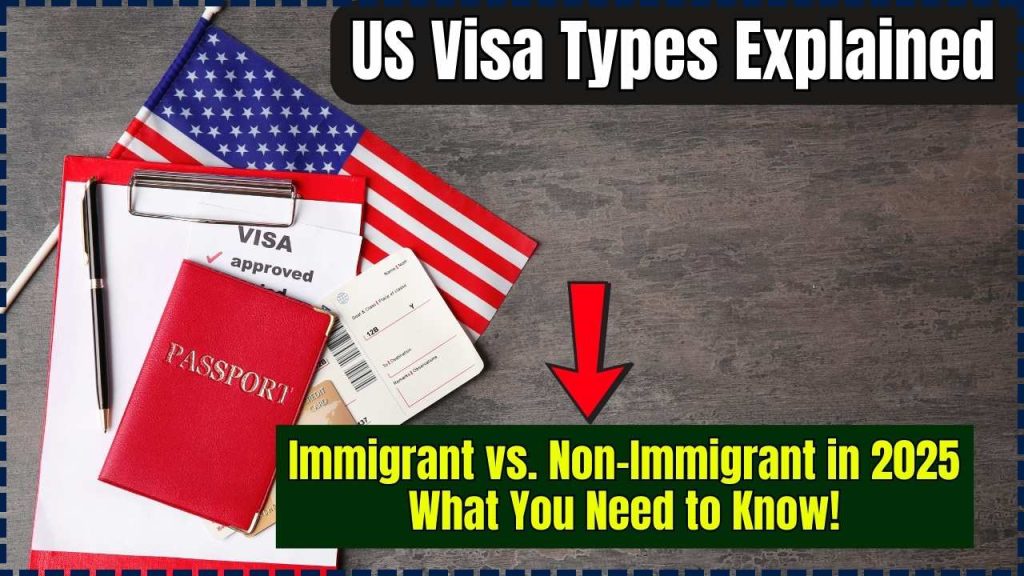US Visa Types Explained: If you’re considering traveling to or settling in the United States, understanding the types of U.S. visas is crucial. Navigating the differences between immigrant and non-immigrant visas can seem daunting, but this guide breaks it all down for you in a simple, easy-to-follow way.

Visas serve as your official permission to enter the U.S. for specific purposes. In 2025, the United States continues to offer a wide range of visa categories, each tailored to unique needs. Whether you’re planning to stay temporarily or move permanently, this guide will provide a roadmap to help you navigate your options. Understanding the options and requirements for each type is essential to ensure a smooth application process and avoid unnecessary delays or complications.
US Visa Types Explained
| Aspect | Immigrant Visa | Non-Immigrant Visa |
|---|---|---|
| Purpose | Permanent residence | Temporary stay |
| Examples | Family-based visas, Employment-based visas (e.g., EB-1 to EB-5) | B-2 (Tourist), F-1 (Student), H-1B (Worker) |
| Duration | Indefinite | Fixed, varies by visa type |
| Eligibility | Relatives, employers, diversity lottery, investors | Tourists, students, temporary workers, business visitors |
| Key Stat | Over 700,000 green cards issued annually (USCIS) | ~10 million non-immigrant visas issued yearly (State Dept.) |
Understanding U.S. visa types in 2025—whether immigrant or non-immigrant—is the first step to achieving your goals. By selecting the right visa, meeting eligibility criteria, and staying informed about policy changes, you’ll maximize your chances of a successful application. Always rely on reputable sources and consult immigration professionals if needed.
What Are Immigrant Visas?
Immigrant visas are for individuals who want to live permanently in the U.S. These visas grant lawful permanent residency (also known as a green card), allowing you to work and reside in the country indefinitely. With a green card, holders can enjoy benefits such as applying for citizenship after meeting residency requirements and sponsoring eligible family members for immigration.
Common Types of Immigrant Visas
1. Family-Based Immigrant Visas
- Immediate Relative (IR) Visas: For spouses, children under 21, and parents of U.S. citizens. These visas have no annual cap, making them highly accessible to qualifying family members.
- Family Preference Visas: For extended family like siblings or married children of U.S. citizens. These visas are limited in number, leading to longer wait times.
2. Employment-Based Immigrant Visas (EB-1 to EB-5)
- EB-1: For individuals with extraordinary abilities, multinational executives, and top-tier researchers. This category is often considered “first preference.”
- EB-2 & EB-3: For professionals, skilled workers, and exceptional talents. These visas cater to those with advanced qualifications or substantial work experience.
- EB-5: For investors contributing $1 million or more to U.S. businesses. In targeted employment areas, the required investment may be reduced to $500,000.
3. Diversity Visa (DV) Lottery
- Annually issues 50,000 visas to applicants from countries with low immigration rates to the U.S. The DV program emphasizes inclusivity and global representation in U.S. immigration.
4. Humanitarian Visas
- For refugees, asylum seekers, and individuals under protective programs like TPS (Temporary Protected Status). These visas aim to provide safety and shelter for individuals fleeing dangerous conditions.
What Are Non-Immigrant Visas?
Non-immigrant visas are for those entering the U.S. temporarily, whether for tourism, study, or work. These visas come with strict conditions and time limits. Unlike immigrant visas, they do not lead to permanent residency, but they offer invaluable opportunities for international visitors to achieve their specific goals in the U.S.
Popular Non-Immigrant Visa Types
1. Tourism and Business (B Visas)
- B-1 Visa: For short-term business activities such as attending conferences, negotiating contracts, or consulting with U.S.-based associates.
- B-2 Visa: For tourism, vacations, or medical treatments. This is the most commonly issued visa for leisure travelers.
2. Student Visas (F, M, J)
- F-1 Visa: For academic studies at U.S.-accredited institutions, including high schools, universities, and language training programs.
- M-1 Visa: For vocational training, such as technical courses or specialized programs.
- J-1 Visa: For exchange programs, including internships and research opportunities, fostering cultural exchange between nations.
3. Temporary Worker Visas
- H-1B Visa: For specialty occupations requiring advanced skills and a bachelor’s degree or higher. This visa is highly sought after in fields like IT, engineering, and healthcare.
- H-2A & H-2B: For seasonal agricultural and non-agricultural workers, respectively. These visas are essential for industries facing seasonal labor shortages.
- O-1 Visa: For individuals with extraordinary abilities in arts, sciences, athletics, or business. It’s often referred to as the “genius visa.”
4. Fiancé Visa (K-1)
- Allows foreign nationals to enter the U.S. to marry a U.S. citizen within 90 days. Once married, the spouse can apply for adjustment of status to become a permanent resident.
How to Choose the Right Visa for Your Needs
1. Assess Your Purpose
- Are you planning to settle permanently or temporarily?
- For permanent residency, explore immigrant visas like family-based or employment-based categories.
- For short-term visits, choose a non-immigrant visa that aligns with your goal, such as tourism or study.
2. Understand Eligibility Requirements
- Each visa type has distinct requirements. For example:
- F-1 Visa: Requires admission to a U.S.-accredited institution and proof of sufficient financial resources.
- EB-5 Visa: Requires significant financial investment and a business plan that creates U.S. jobs.
3. Prepare the Necessary Documents
- Examples include proof of finances, employment letters, university admission letters, and sponsor affidavits. Proper documentation is key to avoiding delays.
4. Stay Updated on Policies
- U.S. immigration policies are subject to change. Check USCIS and State Department websites for updates. Policies surrounding visas like the H-1B are often influenced by political changes and economic needs.
Application Process: A Step-by-Step Guide
- Determine Your Visa Type
- Use the U.S. Visa Wizard to find the right category for your purpose.
- Complete Form DS-160 (Non-Immigrant) or DS-260 (Immigrant)
- Both forms are available online, with detailed instructions and guidance for completion.
- Pay the Visa Fee
- Costs vary by visa type. For example:
- F-1 visa fee: $185.
- EB-5 visa: $3,675.
- Costs vary by visa type. For example:
- Schedule an Interview
- Mandatory for most applicants aged 14–79. Be prepared to demonstrate ties to your home country for non-immigrant visas.
- Attend the Interview
- Provide biometric data, supporting documents, and answer questions about your travel or immigration plans. Dress professionally to make a positive impression.
- Wait for Processing
- Non-immigrant visas often process faster than immigrant visas. For instance, a B-2 visa might take 3 weeks, while an employment-based green card could take several months to years.
How to Get Citizenship in 5 Countries in 5 Years – Complete Process Available from 2025!
Denmark’s 2025 Workforce Recruitment List Includes 162 New Jobs – See If You’re Eligible to Apply!
Edinburgh Futures Institute 2025/2026 Visiting Fellowship Now Available – Check Application Process
FAQs About US Visa Types Explained
1. What is the difference between immigrant and non-immigrant visas?
Immigrant visas are for permanent residence, while non-immigrant visas are for temporary stays and specific purposes like tourism, study, or business.
2. How long does visa processing take?
Processing times vary widely. For example:
- B-2 tourist visa: ~3 weeks.
- Employment-based green cards: Several months to years, depending on the category and country of origin.
3. Can I switch from a non-immigrant to an immigrant visa?
Yes, through “adjustment of status.” For instance, an H-1B worker may apply for a green card if eligible under an employment-based category.
4. What happens if I overstay my visa?
Overstaying can result in penalties, including bans on re-entry, difficulty obtaining future visas, and potential deportation. Always adhere to the visa’s validity period.
5. Are there visa caps for certain categories?
Yes, many visa categories have annual limits. For example, the H-1B visa has a cap of 85,000 new approvals each fiscal year, while family preference immigrant visas also face annual quotas.











